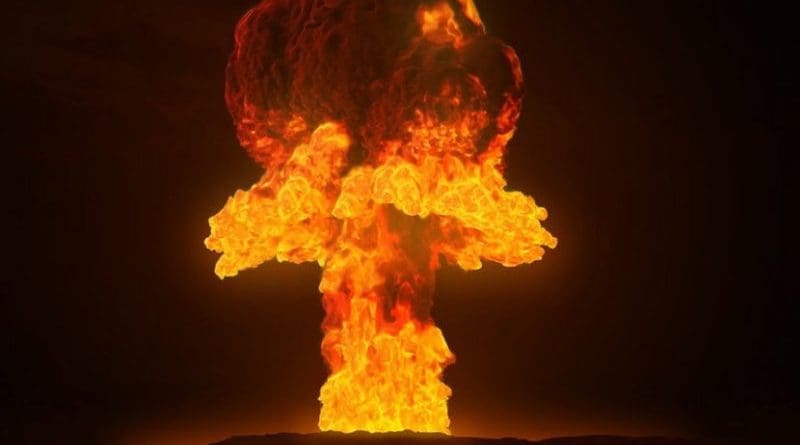Terrorist Groups That Might Pursue Nuclear Terrorism – Analysis
It has been acknowledged that “The essential ingredients of nuclear weapons exist in over 40 countries, and there are scores of sites that are not secure enough to defeat the capabilities that terrorists and criminals have demonstrated.”
Furthermore, Matthew Bunn reports that weapons-usable nuclear material is vulnerable of theft even though many countries have strengthened their nuclear security since 9/11. In addition, it is being alleged that Pakistan’s nuclear stockpiles are an urgent concern; they face threats from Al Qaeda and nuclear insiders who might be willing to sell nuclear weapons technology. As security specialist Shaun Gregory argued that terrorists have attacked Pakistani nuclear facilities three times in the recent past; twice in 2007 and once in 2008.
In June 2002, U.S. citizen Jose Padilla was arrested for allegedly planning a radiological attack on the city of Chicago; however, he was never charged with such conduct. In November 2006, MI5 warned that Al Qaeda was planning on using nuclear weapons against cities in the United Kingdom by obtaining the bombs via clandestine means.
In June 2007, the Federal Bureau of Investigation (FBI) realised to the press the name of Adnan Gulshair el Shukrijumah, allegedly the operations leader for developing tactical plans for detonating nuclear bombs in several American cities, simultaneously.
In November 2007, burglars with unknown intentions infiltrated the Pelindaba nuclear research facility near Pretoria, South Africa. The burglars escaped without acquiring any of the uranium held at the facility. The above mentioned incidents suggest that the existence of such militant groups and individuals can not be denied. Available literature suggests that “Insecure nuclear material anywhere is a threat to everyone, everywhere.”
The world needs an efficient and mechanized agenda to deal this catastrophic terrorism in a collaborative way. According to Charles and William, terrorist groups with the intensions of nuclear terrorism may fall in the following categories: Apocalyptic Groups, Politico-Religious Group, Nationalist/Separatist Groups and Single-Issue Terrorists.
a) Apocalyptic Groups
This type of groups believes that the end of the current world order is close and they must play an active role in promoting this event, this apocalyptic event is an imperative to be furthered with the use of violence. Aum Shinrikyo, Christian Identity Movement, Jewish or Islamic Extremists comes in this category with their belief in the need to cleanse and purify the world via violent upheaval to eliminate non-believers.
b) Politico-Religious Group
These groups are hybrids in a way that they have both political and religious motivations and objectives which are strictly intertwined with their rhetoric, ideology and actions. This politico-religious category range from transnational groups, like Al Qaeda network to the more geographically concentrated Hindu Fundamentalist extremist groups.
c) Nationalist/Separatist Groups
Nationalists/Separatist terrorist groups are those terrorist organizations whose objective is focused on achieving some type of political objective for a given ethnic or tribal group, such as Irish Republic Army (IRA) in Ireland, Srilankan Tamil Tigers (LTTE), and Kurds in Turkey etc.
d) Single-Issue Terrorists
Single-Issue terrorists are defined by a commitment to act as a catalyst to change policies or behavior as it relates to a very clearly defined social or political issue. Such groups could attract extremists who might advocate nuclear terrorism as a way to force the public and government to recognize a perceived problem or concern.
Since 1995, terrorists motivated by religious extremism were responsible for almost two third of terror related fatalities. Many terrorists pride themselves on claiming a religious allegiance and a religiously focused set of objectives, making it very difficult to categorize accurately the core motivations of many regional groups. However, there is no doubt that a growing number of terrorists have established international networks and consider themselves part of a transnational, global fundamentalist movement aggressively seeking change through violent means.
It can be analyzed that the above mentioned groups with established transnational networks may become the major potential threat of nuclear terrorism. As the basic motivations are changing and a new breed of terrorists deeply influenced by religious convention or revenge, violent right wing extremists, apocalyptic and millenarian cults seem to be growing that may be highly prone to commit acts of extreme violence. The overriding religious belief in Armageddon establishes a strong motive for some cults to use the WMDs. Such possibilities can not be overruled, that the terrorist groups motivated by religious belief of Armageddon may pursue the WMDs with intensions to commit acts of terrorism.


“According to Charles and William… ” who are these people? they are not referenced earlier, unless I missed it. Was there an editing problem?